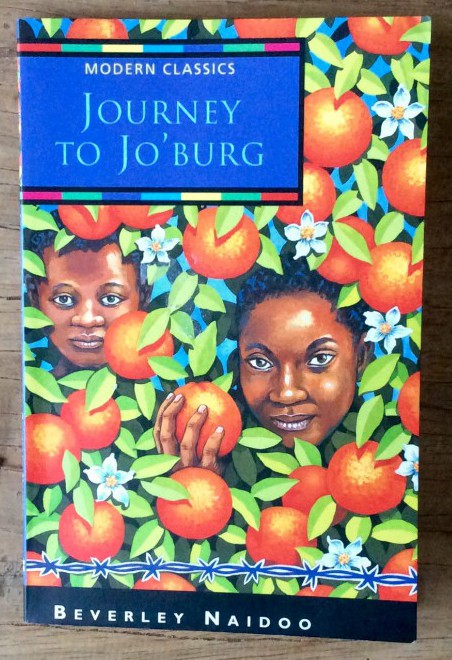Inspiring Young Readers
 posted on 18 Dec 2016
posted on 18 Dec 2016
Journey to Jo'Burg by Beverley Naidoo
Naledi, aged thirteen and her nine year old brother, Tiro live apart from their mother and need to contact her urgently because their baby sister, Dineo is seriously ill. They aren't in foster care and their mother isn't in hospital or in prison, so why don't they all live together? In fact, she is in a kind of prison because as a black South African she was forced to work away from her poor rural community in the city and if she had lost her job, she would be ' illegal' if she was found to be without work. All black people living in the city had to carry identity documents at all times and were not allowed to live in the city of Johannesburg unless they were domestic servants. Otherwise, every evening they would be herded onto buses to return to their designated area, the poor shanty town on the city outskirts known as Soweto. This was the reality of the cruel Apartheid regime in South Africa beginning in 1948 that continued to treat black people with complete disdain until 1994 when Nelson Mandela was democratically elected as the first president.
The engaging plot takes us along with the two children travelling alone on a real journey that is fraught with peril. They know know from personal experience and hearsay that they must be very careful about whom they trust. Their quest involves some monstrous people who could put them in terrible danger. But they are driven by their need to find their mother and fortunately they meet the kindness of several strangers along the way. Naidoo's skilful writing creates a tense little thriller but tempers it with plenty of hope and optimism which is what makes it so special. The two main protagonists are drawn very sympathetically by a writer who clearly knows and likes children. They are complex wise little creatures whose biggest strengths are compassion and stoicism. As they travel they learn more about their country and its history, including the real massacre of Soweto children in 1976 who dared to protest about their restricted education under the regime. We are learning too as along the way they reveal that their father had died as a result of working in terrible conditions in the mining industry. Working a long way from home, he had only been able to see them once a year, a memory they treasure.
Despite the urgency of needing to see her youngest child, their mother is not allowed to return home with them until the following day because her employer needs her for a dinner party. Naledi and Tiro are forbidden to stay overnight with their mother so they have to stay in Soweto with a friend they made along the way. When they return to the village with their mother and take the baby to hospital, they experience the inadequacy and expense of healthcare. They realise that being poor means making terribly hard decisions about managing to feed and care for a family. Naledi learns a great deal about herself as a result of the experience and inspired by the story of the Soweto schoolchildren, resolves to fight for a fairer system in whatever way she can.
These are the kind of stories that, if experienced at the right age, help children to become wise and to seek social justice for people living in difficult times. These are the kind of 'values' that should be driving the curriculum in schools and so I do hope that the book is still widely read and used in schools. I would imagine that children would gasp with disbelief and outrage at many points and ask lots of questions.
In the postscript to this story, Naidoo provides some very relevant personal context. As a privileged white South African child she and her family were cared for by Mary, a black servant whose own three daughters lived 150 miles away. She didn't question this at all but remembers her receiving a devastating telegram to inform her that two of these children had died as a result of diphtheria. Naidoo goes on to explain that she did not really become aware of the injustice of the system until she was at university. From this point she became an activist in the anti Apartheid movement which included being arrested and subsequently a period of eight weeks in jail. Living in England several years later she was determined to find a way of telling her own young children and others about what continued to happen in South Africa. As she was married to a fellow exile with an Asian heritage, they would not be allowed to live as a family there as 'mixed' marriages were forbidden. And so she wrote what has since become regarded as a modern classic. The Guardian review described it as ' ....the more searing for its gentleness ' and I would agree. The tone is always measured and matter of fact even when the authors is describing terrible things. As Naidoo has herself once written:
' Literature is political and ones choice of literature is political, although the reader may of course, ignore or simply not see the meanings that are there.'
This fictional story based on a living under a divisive regime was written for a specific purpose and the messages shout out loud and clear. But as well as this it is eventful, well- paced and with memorable characters. It also includes some beautifully understated drawings that add to the content. So, a powerful little book that was viewed as being so dangerous that it was banned in South Africa until 1991. In my view that makes it very special.
Karen Argent
December 2016